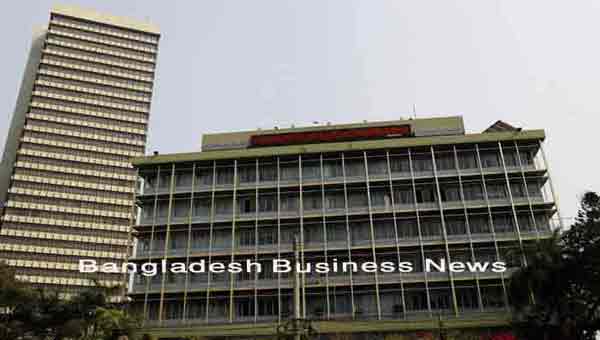

Bangladesh Bank Headquarters
Dhaka, Bangladesh (BBN) - The central bank of Bangladesh sees the banking sector faced some pressures from asset quality, particularly in the state owned banks, and tighter liquidity in some of the fourth generation private banks.
The gap between credit and deposit growths in a low interest environment helped absorb the existing excess liquidity in the banking system, according to the latest Bangladesh Bank Quarterly (BBQ) assessment for July-September 2017.
“Liquidity conditions in the banking system remains adequate against the backdrop of stable capital to risk-weighted-asset ratio (CRAR), although non-performing loan (NPL) has slightly increased during the quarter under review,” the BBQ explained.
Meanwhile, growth in private sector credit was on an upward trend and reached 17.9 per cent in September 2017, exceeding the Bangladesh Bank (BB)'s FY (fiscal year) 2017-18 target. The large share of the credit went in to industry, construction and transport sectors.
However, private credit growth overshot somewhat due to a sharp pickup in lending by the private commercial banks, the BB added.
The central bank of Bangladesh also indentified downside risks like any shock to remittance inflow and export due to growing political uncertainty in the Middle East.
“Risks to inflation could emerge from the second-round effects of elevated food prices and the pass-through of higher global fuel and commodity prices,” it noted.
The BBQ also said: “High credit growth amid tightening liquidity in the banking system, strong import growth with a smaller overall BoP (balance of payments) balance, and the rising trend in food inflation warrant a cautious macroeconomic management for preserving monetary and financial stability in FY 18.”
Strong import growth (28.4 per cent in the Q1of FY18)-fueled by capital machinery and intermediate goods imports-against 7.7per cent export growth widened trade deficit, according to the BBQ.
It also said: “Wider trade deficit, coupled with improving but modest remittance growth, led to a deficit in overall BoP in the Q1 of FY18.”
The BBQ further said the pace of economic activities remained robust in the first quarter of FY18, aided by rapid private credit growth, a rebound in remittance inflows, and a pick-up in export growth.
On the supply side, growth momentum was strong in the industry and the service sectors, while agriculture witnessed a softer growth due to the recent floods.
Inflation, as measured by consumer price index (CPI) on a year-on-year basis, has been on the rise since January 2017, driven mainly by food-price rises.
Consequently, inflation (12-month moving average) crept up, reaching 5.6 percent in Q1FY18, slightly exceeding the FY18 target of 5.5 percent.
“Flood-related crop losses, a declining buffer stock of rice, excess demand due to the influx of refugees from Myanmar, and an uptick in food prices in the global market led to elevated food prices in the domestic market,” it explained.
The central bank, however, predicted that political and macroeconomic conditions are likely to be broadly stable in the fiscal year (FY) 2017-18.
“Strong growth in capital machinery import reflects buoyant investment demand. In the light of the strong economic activities, output growth is expected to be attained at closer to the target,” the BBQ noted.
BBN/SSR/AD